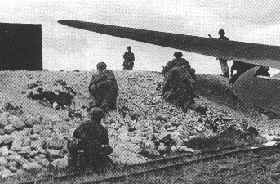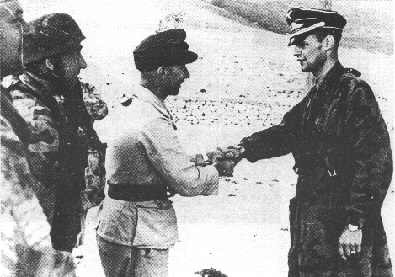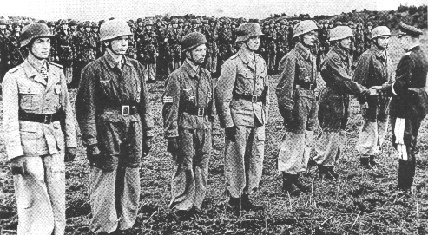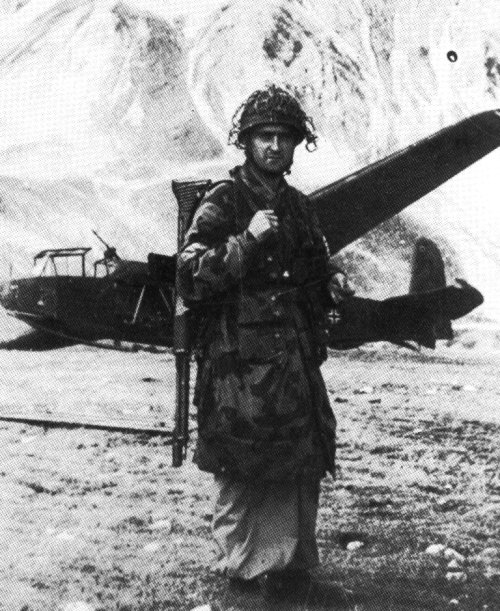privatehudson
The Ultimate Badass
- Joined
- Oct 15, 2003
- Messages
- 4,821
Read most basic books about WW2 and the answer will be virtually guaranteed to be the same, Otto Skorzeny and a detachment of SS Paratroopers. This article which seeks not to offer an alternative answer to the question as such, but to shed some light on a part of the operation often ignored.
Background
By 1943, Italy was losing the war. In July 1943, Mussolini was deposed by a revolt within his own Fascist Grand Council, and Vittorio Emmanuelle III, the King of Italy, reduced to a figure head by Mussolini, appointed Field Marshal Pietro Badoglio to be the new Prime Minister of Italy. Mussolini is arrested. Determined to stand by his fellow dictator, and unable to accept the collapse of an Axis power, Hitler orders preparations to be made to rescue Mussolini and within just over a month will invade Italy when she surrenders.
Hitler personally chooses Otto Skorzeny from a group of officers to lead the attempt to locate and Rescue Mussolini. Skorzeny has been appointed to command the Friedenthaler Jagdverbande, essentially a commando unit shortly beforehand, and the unit had yet to prove itself in combat. A frantic hunt begins for Mussolini who is whisked from one location to another by the Italian authorities. Accounts differ as to how they discovered he was being held at Gran Sasso d'Italia, but after some false starts they finally believed him to be there. Gran Sasso d'Italia was a high peak in the Apennine mountains 80 miles north east of Rome, with a small hotel on it. Access to the Campo Imperatore hotel was only by cable car or climbing the peak. The scene was set for a daring raid…
The Raid – The SS version
Let me offer some quotes about the raid from sites on the net one might use to find out about this mission, for example from Wikipedia’s article on Skorzeny.
It was in this role, in July 1943, that he was personally selected by Hitler, from among half a dozen Luftwaffe and Army special agents, to lead the operation to rescue Benito Mussolini, the dictator of Italy and a friend of Hitler's, who had been removed from power and imprisoned by the Italian government.
Almost two months of cat-and-mouse followed, as the Italians moved Mussolini from place to place in order to frustrate any would-be rescuers. Finally, on September 12, Skorzeny led a daring glider-based assault on the Gran Sasso Hotel, high in the Apennines mountains, and rescued Mussolini with very few shots being fired. The exploit earned Skorzeny worldwide fame, promotion to major and the Knight's Cross, another major German military honor.
Or from another site on the man
Hitler personally ordered Skorzeny to rescue Mussolini, and also seemed to take a shine to his
hulking countryman. So, Otto set out to do just that. He tracked Mussolini across half of Italy
for a month and a half until he finally found him at the Hotle Campo, a resort high in
the Gran Sasso mountains. Otto formulated a plan and went right into action.
He took a contingent of his troops up in gliders and crashed them on the steep rocky slopes
surrounding the hotel. He and his troops rushed out and stormed the hotel, capturing the place
without a shot. Mussolini was promptly loaded onto an aircraft that landed after the assault and
flown to Vienna. There he and Skorzeny recieved a hero's welcome. Otto was promoted,
awarded Germany's highest medal for heroism and became the toast of the Reich.
All very fine and complete you might say, but not the entire story in the slightest.
The Raid – The Fallschirmjäger version
Reading the above quotes you could almost get the impression that Skorzeny and a small number of men captured Gran Sasso almost single-handedly, the Fallschirmjäger say differently though. From the very start the mission was placed under the specific control of Karl Student, yes that would be the senior Fallschirmjäger commander himself no less, and even Skorzeny was required to take orders from him. To the Fallschirmjäger the mission orders were very clear, they would capture Mussolini, Skorzeny would take control of ensuring his safety after the capture. The two roles were clearly defined and separate, Skorzeny was the political part, the Fallschirmjäger the military.
From the beginning of the operation aimed at Gran Sasso the Fallschirmjäger were deeply involved. Major Mors, commander of a Fallschirmjäger battalion was tasked with assisting in the raid and the planning. It was clear to all that a ground assault was out, any attack would take far too long to reach the summit by cable car. A parachute drop was also abandoned as an idea, the high winds in the area would scatter the troops too widely. During a reconnaissance flight though a small grassy area in front of the hotel was discovered and deemed perfect for a glider landing.
The plan took shape. Skorzeny would accompany the 1st company of the Fallschirmjäger battalion in a glider assault on the hotel whilst the remainder of the battalion would secure the valley below and the cable car. Once Mussolini was secure he would be evacuated and the troops would leave via the cable car, into the valley and then away from the area. An Italian, General Soletti was brought along in order to calm things down if fighting began.
Unfortunately, as they have a tendency to do, things went wrong from the start. Two gliders were damaged on take off, and the 2 gliders leading the formation (one of which was carrying the 1st Company’s commanding officer) disappeared in the dense cloud and fell behind. Skorzney’s group now lead the formation to the peak. Touching down first Skorzeny and his men swept past the stunned Italian guards using a mix of bluff, violence (usually a SMG butt) and intimidation to reach Mussolini without a shot being fired. Other Gliders crashed into the grassy area and forced the surrender of the Italian guards, thus securing the area. The first part of the mission was accomplished.
Now came the choice of Evacuation. The valley had been secured by Mors and his men, and Mors arrived soon after via cable car. Skorzeny declined this route though mentioning that Partisan activity was strong there, and chose to evacuate via the air, calling in two Storch aircraft. The first of which (flown by Student’s own personal pilot Captain Gerlach) touched down fine, but the second damaged it’s landing gear on impact as the grassy area was littered with rocks. The plan had been to fly out in two planes, but Skorzeny bundled himself, Gerlach and Mussolini into the sole Storch and flew a short distance to the airfield where the raid began. From there they changed onto a Heinkel 111 and flew to Vienna and safety. Mors and the rest of the battalion evacuated with ease from the valley and the mission was a success.
The Raid – So why are the Fallschirmjäger ignored?
This is an interesting question which owes much to an understanding of Nazi Politics during WW2. The almost constant rivalry between those under Hitler manifested itself in many ways, and this is one of them. Skorzeny was an SS soldier, his men were an SS unit, his “chief” was Heinrich Himmler. Mors and the Fallschirmjäger came under the political control of the Luftwaffe, and his “chief” was Goring. The rivalry between these two factions was intense, and though the mission was ultimately under Student’s command, the glory went to Skorzeny and the SS.
Skorzeny’s decision on how to get Mussolini off the peak partly shows this. He was supposed to fly out in the second Storch and meet at the nearby airfield to escort Mussolini onto Vienna. When the 2nd plane crashed, it may have been prudent for Skorzeny to evacuate via the cable car, and fly Mussolini out. The Storch at best is designed to hold 2 people, and neither Skorzeny or Mussolini were light people. Taking off from a small grassy slope at the end of which is a cliff and sheer drop when so overloaded was near to suicide. It’s said that Skorzeny worried that if the plane was hit and forced to land it was his duty to be there to protect Mussolini. I though think that his decision was more than a little affected by his desire to inform Himmler as soon as practical and seize the glory for himself.
Skorzeny was able to inform Himmler quickly of the success, and Himmler immediately told Hitler, portraying it as a coup for the new SS unit. In the meantime Mors informed Student about the raid, but when Student came to tell Goring, Goring did not even know it was taking place! By the time Goring came to speak with Hitler about it, the propaganda was in place, Hitler was firmly of the belief that the SS were responsible for the success, and little Goring could do would change that.
Propaganda played a huge part in the mission with many photographers and newspapermen being brought with them. Many photos still survive of the mission and prove the presence of the Fallschirmjäger in the assault on the peak. The SS version of the story is more often quoted though, and when the Fallschirmjäger are spoken of, it is usually only in passing rather than in detail of their role or importance. To Skorzeny went promotion and the Knights Cross and the congratulations of Hitler. To the Fallschirmjäger went the congratulations of Student but virtually no recognition of their efforts elsewhere.
Conclusion
This article has no intention of saying that the Fallschirmjäger rescued Mussolini, or that their role was more important than that of Skorzeny and his men. The article is merely an attempt to inform people that the raid was not solely the efforts of Skorzeny. Note that in some internet pages like I showed, the FJ part of the operation is still ignored or minimalised. This is not the case in all sites and books, but it is in many of them. The misconceptions about the raid persist to this day. The Fallschirmjäger deserve recognition for their efforts that Hitler and much of history has denied them. So yes, Skorzeny rescued Mussolini, but he couldn’t have done it without the Fallschirmjäger, and does not deserve all the credit given for it to him alone.
Below is a few photos related to the raid:

Fallschirmjäger securing the perimeter of the hotel during the raid

Oberleutnant von Berlepsch (Right, commander of the 1st Company) greets Major Mors (centre) and Oberleutnant Schulze after they reach the top of the mountain.

Student decorates various people involved in the raid

One of the SS troops involved in the raid with a FJ42 slung over his shoulder. In the background you can see one of the gliders used, probably a one of the middle ones to arrive as the first few detached their MGs to use in the raid if necessary, and the last few crash landed. The extent of the slope is also clear in the picture, it may not look much, but landing on it was no picnic!

Otto Skorzeny, the man history tends to record as being Mussolini's rescuer.
Background
By 1943, Italy was losing the war. In July 1943, Mussolini was deposed by a revolt within his own Fascist Grand Council, and Vittorio Emmanuelle III, the King of Italy, reduced to a figure head by Mussolini, appointed Field Marshal Pietro Badoglio to be the new Prime Minister of Italy. Mussolini is arrested. Determined to stand by his fellow dictator, and unable to accept the collapse of an Axis power, Hitler orders preparations to be made to rescue Mussolini and within just over a month will invade Italy when she surrenders.
Hitler personally chooses Otto Skorzeny from a group of officers to lead the attempt to locate and Rescue Mussolini. Skorzeny has been appointed to command the Friedenthaler Jagdverbande, essentially a commando unit shortly beforehand, and the unit had yet to prove itself in combat. A frantic hunt begins for Mussolini who is whisked from one location to another by the Italian authorities. Accounts differ as to how they discovered he was being held at Gran Sasso d'Italia, but after some false starts they finally believed him to be there. Gran Sasso d'Italia was a high peak in the Apennine mountains 80 miles north east of Rome, with a small hotel on it. Access to the Campo Imperatore hotel was only by cable car or climbing the peak. The scene was set for a daring raid…
The Raid – The SS version
Let me offer some quotes about the raid from sites on the net one might use to find out about this mission, for example from Wikipedia’s article on Skorzeny.
It was in this role, in July 1943, that he was personally selected by Hitler, from among half a dozen Luftwaffe and Army special agents, to lead the operation to rescue Benito Mussolini, the dictator of Italy and a friend of Hitler's, who had been removed from power and imprisoned by the Italian government.
Almost two months of cat-and-mouse followed, as the Italians moved Mussolini from place to place in order to frustrate any would-be rescuers. Finally, on September 12, Skorzeny led a daring glider-based assault on the Gran Sasso Hotel, high in the Apennines mountains, and rescued Mussolini with very few shots being fired. The exploit earned Skorzeny worldwide fame, promotion to major and the Knight's Cross, another major German military honor.
Or from another site on the man
Hitler personally ordered Skorzeny to rescue Mussolini, and also seemed to take a shine to his
hulking countryman. So, Otto set out to do just that. He tracked Mussolini across half of Italy
for a month and a half until he finally found him at the Hotle Campo, a resort high in
the Gran Sasso mountains. Otto formulated a plan and went right into action.
He took a contingent of his troops up in gliders and crashed them on the steep rocky slopes
surrounding the hotel. He and his troops rushed out and stormed the hotel, capturing the place
without a shot. Mussolini was promptly loaded onto an aircraft that landed after the assault and
flown to Vienna. There he and Skorzeny recieved a hero's welcome. Otto was promoted,
awarded Germany's highest medal for heroism and became the toast of the Reich.
All very fine and complete you might say, but not the entire story in the slightest.
The Raid – The Fallschirmjäger version
Reading the above quotes you could almost get the impression that Skorzeny and a small number of men captured Gran Sasso almost single-handedly, the Fallschirmjäger say differently though. From the very start the mission was placed under the specific control of Karl Student, yes that would be the senior Fallschirmjäger commander himself no less, and even Skorzeny was required to take orders from him. To the Fallschirmjäger the mission orders were very clear, they would capture Mussolini, Skorzeny would take control of ensuring his safety after the capture. The two roles were clearly defined and separate, Skorzeny was the political part, the Fallschirmjäger the military.
From the beginning of the operation aimed at Gran Sasso the Fallschirmjäger were deeply involved. Major Mors, commander of a Fallschirmjäger battalion was tasked with assisting in the raid and the planning. It was clear to all that a ground assault was out, any attack would take far too long to reach the summit by cable car. A parachute drop was also abandoned as an idea, the high winds in the area would scatter the troops too widely. During a reconnaissance flight though a small grassy area in front of the hotel was discovered and deemed perfect for a glider landing.
The plan took shape. Skorzeny would accompany the 1st company of the Fallschirmjäger battalion in a glider assault on the hotel whilst the remainder of the battalion would secure the valley below and the cable car. Once Mussolini was secure he would be evacuated and the troops would leave via the cable car, into the valley and then away from the area. An Italian, General Soletti was brought along in order to calm things down if fighting began.
Unfortunately, as they have a tendency to do, things went wrong from the start. Two gliders were damaged on take off, and the 2 gliders leading the formation (one of which was carrying the 1st Company’s commanding officer) disappeared in the dense cloud and fell behind. Skorzney’s group now lead the formation to the peak. Touching down first Skorzeny and his men swept past the stunned Italian guards using a mix of bluff, violence (usually a SMG butt) and intimidation to reach Mussolini without a shot being fired. Other Gliders crashed into the grassy area and forced the surrender of the Italian guards, thus securing the area. The first part of the mission was accomplished.
Now came the choice of Evacuation. The valley had been secured by Mors and his men, and Mors arrived soon after via cable car. Skorzeny declined this route though mentioning that Partisan activity was strong there, and chose to evacuate via the air, calling in two Storch aircraft. The first of which (flown by Student’s own personal pilot Captain Gerlach) touched down fine, but the second damaged it’s landing gear on impact as the grassy area was littered with rocks. The plan had been to fly out in two planes, but Skorzeny bundled himself, Gerlach and Mussolini into the sole Storch and flew a short distance to the airfield where the raid began. From there they changed onto a Heinkel 111 and flew to Vienna and safety. Mors and the rest of the battalion evacuated with ease from the valley and the mission was a success.
The Raid – So why are the Fallschirmjäger ignored?
This is an interesting question which owes much to an understanding of Nazi Politics during WW2. The almost constant rivalry between those under Hitler manifested itself in many ways, and this is one of them. Skorzeny was an SS soldier, his men were an SS unit, his “chief” was Heinrich Himmler. Mors and the Fallschirmjäger came under the political control of the Luftwaffe, and his “chief” was Goring. The rivalry between these two factions was intense, and though the mission was ultimately under Student’s command, the glory went to Skorzeny and the SS.
Skorzeny’s decision on how to get Mussolini off the peak partly shows this. He was supposed to fly out in the second Storch and meet at the nearby airfield to escort Mussolini onto Vienna. When the 2nd plane crashed, it may have been prudent for Skorzeny to evacuate via the cable car, and fly Mussolini out. The Storch at best is designed to hold 2 people, and neither Skorzeny or Mussolini were light people. Taking off from a small grassy slope at the end of which is a cliff and sheer drop when so overloaded was near to suicide. It’s said that Skorzeny worried that if the plane was hit and forced to land it was his duty to be there to protect Mussolini. I though think that his decision was more than a little affected by his desire to inform Himmler as soon as practical and seize the glory for himself.
Skorzeny was able to inform Himmler quickly of the success, and Himmler immediately told Hitler, portraying it as a coup for the new SS unit. In the meantime Mors informed Student about the raid, but when Student came to tell Goring, Goring did not even know it was taking place! By the time Goring came to speak with Hitler about it, the propaganda was in place, Hitler was firmly of the belief that the SS were responsible for the success, and little Goring could do would change that.
Propaganda played a huge part in the mission with many photographers and newspapermen being brought with them. Many photos still survive of the mission and prove the presence of the Fallschirmjäger in the assault on the peak. The SS version of the story is more often quoted though, and when the Fallschirmjäger are spoken of, it is usually only in passing rather than in detail of their role or importance. To Skorzeny went promotion and the Knights Cross and the congratulations of Hitler. To the Fallschirmjäger went the congratulations of Student but virtually no recognition of their efforts elsewhere.
Conclusion
This article has no intention of saying that the Fallschirmjäger rescued Mussolini, or that their role was more important than that of Skorzeny and his men. The article is merely an attempt to inform people that the raid was not solely the efforts of Skorzeny. Note that in some internet pages like I showed, the FJ part of the operation is still ignored or minimalised. This is not the case in all sites and books, but it is in many of them. The misconceptions about the raid persist to this day. The Fallschirmjäger deserve recognition for their efforts that Hitler and much of history has denied them. So yes, Skorzeny rescued Mussolini, but he couldn’t have done it without the Fallschirmjäger, and does not deserve all the credit given for it to him alone.
Below is a few photos related to the raid:

Fallschirmjäger securing the perimeter of the hotel during the raid

Oberleutnant von Berlepsch (Right, commander of the 1st Company) greets Major Mors (centre) and Oberleutnant Schulze after they reach the top of the mountain.

Student decorates various people involved in the raid

One of the SS troops involved in the raid with a FJ42 slung over his shoulder. In the background you can see one of the gliders used, probably a one of the middle ones to arrive as the first few detached their MGs to use in the raid if necessary, and the last few crash landed. The extent of the slope is also clear in the picture, it may not look much, but landing on it was no picnic!

Otto Skorzeny, the man history tends to record as being Mussolini's rescuer.

 You would have thought that the Italians
You would have thought that the Italians  . I always thought that
. I always thought that




